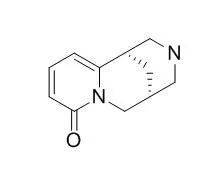| Animal Research: |
| Neuropharmacology. 2015 Mar 31;95:206-214. | | Agonist and antagonist effects of cytisine in vivo.[Pubmed: 25839895] | Varenicline, the most successful smoking cessation aid, is a selective partial agonists at α4β2* nicotinic receptors. Its efficacy is likely to be shared by other drugs with similar receptor action, including Cytisine.
METHODS AND RESULTS:
The present study aimed to characterize behavioral effects of Cytisine compared with nicotine using locomotor activity tests, intracranial self-stimulation of ventral tegmental area (discrete-trial threshold current intensity titration procedure), drug discrimination (0.6 mg/kg nicotine from vehicle), physical dependence (osmotic minipumps delivering 6 mg/kg/day of nicotine) and intravenous nicotine self-administration (0.01 mg/kg per infusion) in adult Wistar rats. Cytisine (1-3 mg/kg) partially substituted for nicotine and at the highest dose tended to antagonize nicotine's discriminative stimulus effects. Nicotine (0.05-0.4 mg/kg), but not Cytisine (0.3-3 mg/kg), lowered ICSS thresholds and Cytisine dose-dependently reversed effects of nicotine. Nicotine (0.15-0.6 mg/kg), but not Cytisine (0.3-3 mg/kg), stimulated locomotor activity and Cytisine (3 mg/kg) fully reversed these effects of nicotine. Acute pretreatment with nicotine (0.15-0.6 mg/kg), but not Cytisine (0.3-3 mg/kg), reinstated extinguished nicotine self-administration. Continuous infusion of nicotine induced physical dependence, as indicated by reduced rates of food-reinforced responding induced by a challenge dose of mecamylamine. At the highest tested dose (3 mg/kg), Cytisine tended to reduce response rates irrespective of whether the rats were continuously exposed to nicotine or saline.
CONCLUSIONS:
Cytisine behaves like a weak partial agonist, mimicking effects of nicotine to a limited degree. Although Cytisine reversed several effects of nicotine, it seemed to have a reduced potential to produce withdrawal signs in nicotine-dependent subjects. | | J Pharmacol Exp Ther. 2009 Apr;329(1):377-86 | | Cytisine-based nicotinic partial agonists as novel antidepressant compounds.[Pubmed: 19164465] | Nicotine and other nicotinic agents are thought to regulate mood in human subjects and have antidepressant-like properties in animal models. Recent studies have demonstrated that blockade of nicotinic acetylcholine receptors (nAChRs) including those containing the beta2 subunit (beta2(*)), results in antidepressant-like effects. Previous studies have shown that Cytisine, a partial agonist at alpha4/beta2(*) nAChRs, and a full agonist at alpha3/beta4(*) and alpha7 nAChRs, has antidepressant-like properties in several rodent models of antidepressant efficacy; however, it is not clear whether more selective partial agonists will also be effective in these models.
METHODS AND RESULTS:
We tested Cytisine and two derivatives, 5-bromo-Cytisine (5-Br-Cyt) and 3-(pyridin-3'-yl)-Cytisine (3-pyr-Cyt) for their ability to act as a partial agonist of different nAChR subtypes and to show antidepressant-like activity in C57/BL6 mice in the tail suspension, the forced-swim, and the novelty-suppressed feeding tests. 3-pyr-Cyt was a partial agonist with very low efficacy at alpha4/beta2(*) nAChRS but had no agonist effects at other nAChRs normally targeted by Cytisine, and it was effective in mouse models of antidepressant efficacy. Animals showed dose-dependent antidepressant-like effects in all three behavioral paradigms. 5-Br-Cyt was not effective in behavioral tests when administered peripherally, probably because of its inability to penetrate the blood-brain barrier, because it efficiently reduced immobility in the tail suspension test when administered intraventricularly.
CONCLUSIONS:
These results suggest that novel nicotinic partial agonists may provide new possibilities for development of drugs to treat mood disorders. |
|






 Cell. 2018 Jan 11;172(1-2):249-261.e12. doi: 10.1016/j.cell.2017.12.019.IF=36.216(2019)
Cell. 2018 Jan 11;172(1-2):249-261.e12. doi: 10.1016/j.cell.2017.12.019.IF=36.216(2019) Cell Metab. 2020 Mar 3;31(3):534-548.e5. doi: 10.1016/j.cmet.2020.01.002.IF=22.415(2019)
Cell Metab. 2020 Mar 3;31(3):534-548.e5. doi: 10.1016/j.cmet.2020.01.002.IF=22.415(2019) Mol Cell. 2017 Nov 16;68(4):673-685.e6. doi: 10.1016/j.molcel.2017.10.022.IF=14.548(2019)
Mol Cell. 2017 Nov 16;68(4):673-685.e6. doi: 10.1016/j.molcel.2017.10.022.IF=14.548(2019)